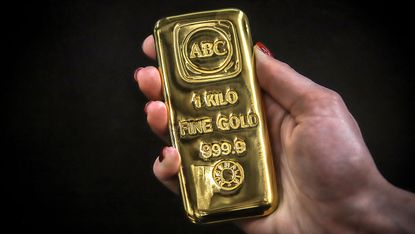Gold could set new records, even from here – here’s how to invest
The gold price has soared in recent days, and it could go higher yet, says John Stepek. Either way, you should hold some gold in your portfolio.


In September 2011, gold hit an all-time high in US dollars of $1,923.70 an ounce. That was an intraday high (ie, it happened during the session). The closing high was a bit lower, set in August 2011 at $1,891.90.
Both of those highs have now been beaten. Gold ended the day on Friday at $1,897.50, a new closing high, while this morning it rose to a new intraday high of $1,944.39.
It’s only taken nine years. Good things come to those who wait, it seems.
Subscribe to MoneyWeek
Subscribe to MoneyWeek today and get your first six magazine issues absolutely FREE

Sign up to Money Morning
Don't miss the latest investment and personal finances news, market analysis, plus money-saving tips with our free twice-daily newsletter
Don't miss the latest investment and personal finances news, market analysis, plus money-saving tips with our free twice-daily newsletter
Of course, you could argue that these numbers are not as significant as they might seem. As John Authors points out in his Bloomberg newsletter this morning, once you take inflation into account, gold is still below the 2011 US dollar high. That in itself was also below the 1980 high, which saw gold spike to $850-odds.
Also, gold has been setting new all-time highs in pretty much every other global currency for a while now. For example, gold’s 2011 high in pounds was around £1,180. Today, it’s around £1,500.
Lest you think this is purely Brexit-related, it’s the same story for the euro. A record high in 2012 (just after European Central Bank boss Mario Draghi drew a line under the eurozone crisis with his “whatever it takes” speech) of around €1,380 has given way to fresh highs above €1,600.
So, yes, gold still has a way to go to hit an inflation-adjusted dollar high. And yes, it’s a very dollar-centric way to look at things, given that gold has been hitting new records in every other currency for ages.
But the US dollar is the most important currency in the world. And the fact that gold has now hit a genuinely new high in said currency, means that it’ll draw a lot more attention than all the other new highs did.
What’s next for gold?
So, what now? In the short term, as with any asset, it’s anyone’s guess. You shouldn’t be worrying about the short term, because you’re not a day trader.
(But in case you are, be aware that the Federal Reserve is holding its latest meeting on monetary policy this week, with the outcome announced on Wednesday evening our time – so there’s the potential for volatility, setbacks, etc around that.)
In the longer term, we like gold for two reasons.
One, we see it as portfolio insurance. It’s something you should always have in your portfolio – along with bonds, equities (and property), plus cash – simply because it does something that no other asset class does.
Gold doesn’t rely on any other counterparty for its value. If you own equity, the underlying company can go bust. If you own a bond, the underlying company or government can go bust. And if own cash, the underlying government can go bust.
Gold is just an inert, relatively rare metal that human beings happen to place a value on. So it has “intrinsic" value.
That value goes up and down depending on what’s happening in the world. But it’s highly unlikely to go to zero until we can produce it out of thin air, in which case we’ll have solved the scarcity problem and we won’t need money anymore in any case.
That’s what makes gold unique. That’s what gives it its diversifying properties. And that’s why we reckon you should pretty much always own at least a bit of gold, regardless of the backdrop, or whether the outlook is bullish or bearish for the yellow metal. This is the reason why we’ve always told you to own it.
Conditions are ripe for further gains
However, currently we also like gold for a second reason – because the conditions are ripe for gold to continue to go higher. And while it’s now hit a record high (and so might take a breather, or might not), we still think there’s room for it to go higher.
I explained the key reason why in the most recent issue of MoneyWeek magazine (you can get your first six issues free here if you don’t already subscribe). But to cut a long story short, if inflation goes up and interest rates stay where they are, that’s good news for gold.
Obviously gold has come a long way. But the levels of exuberance (magazine covers, mainstream news appearances) that we saw in 2011 aren’t apparent yet.
That’s partly because gold’s got plenty of competition from the likes of tech stocks and Tesla to keep investors occupied. But it’s also because this has been a particularly stealthy and quick bull market.
I mean, it was only a few months ago that market pundits were pointing at gold’s slide during the early days of the coronavirus crash and joking about its “safe haven” qualities, having failed to understand that in a crash, the quality stuff (blue chips, Treasuries, precious metal) gets sold off to fund margin calls on all the dodgy stuff.
So, while I expect gold to get a few headlines now, and while we’ve seen the occasional big number target ($3,000 from Bank of America a few months ago), I don’t think we’re at the peak yet.
So, if you don’t own gold, it’s worth holding some. You can invest via bullion dealers (either get the gold and stick it in a safe, or pay them to store it for you). Or you can use an exchange-traded fund (ETF) – go for the physical-backed ones.
If you own gold, but you are interested in placing a bet on prices rising further, then there are other options to consider.
Silver has rocketed even faster than gold. It’s a brutally volatile, contrary, vicious metal (Dominic has written of his painful history with silver here), but if you have the stomach for it, then you could look into the silver ETF. Just bear in mind that silver really does swing about a lot – the last time it hit its peak of nearly $50 an ounce in April 2011, it practically halved in value the following month.
Another potential catch-up play is the precious metals miners. These have come a long way since their coronavirus March lows (the junior miners ETF has more than doubled, for example). However, if gold stays at these levels or goes higher, then they should be able to rise a good deal further.
Last time gold was at these levels, the miners were spraying cash around the room like they had their own personal central bank printing presses. These days there’s less exuberance, as Dominic recently pointed out.
Which miners? We’ve discussed some individual ideas in MoneyWeek magazine (another good reason to subscribe), but if you’re not a stock picker – and bear in mind that even a mining index is risky let alone buying individual miners – then sticking with a tracker or a gold mining fund is your best bet.
The implications of a soaring gold price are not necessarily happy news for most other assets. But we’ll discuss that another day. This is why we diversify, after all.
John is the executive editor of MoneyWeek and writes our daily investment email, Money Morning. John graduated from Strathclyde University with a degree in psychology in 1996 and has always been fascinated by the gap between the way the market works in theory and the way it works in practice, and by how our deep-rooted instincts work against our best interests as investors.
He started out in journalism by writing articles about the specific business challenges facing family firms. In 2003, he took a job on the finance desk of Teletext, where he spent two years covering the markets and breaking financial news. John joined MoneyWeek in 2005.
His work has been published in Families in Business, Shares magazine, Spear's Magazine, The Sunday Times, and The Spectator among others. He has also appeared as an expert commentator on BBC Radio 4's Today programme, BBC Radio Scotland, Newsnight, Daily Politics and Bloomberg. His first book, on contrarian investing, The Sceptical Investor, was released in March 2019. You can follow John on Twitter at @john_stepek.
-
 Coventry Building Society bids £780m for Co-operative Bank - what could it mean for customers?
Coventry Building Society bids £780m for Co-operative Bank - what could it mean for customers?Coventry Building Society has put in an offer of £780 million to buy Co-operative Bank. When will the potential deal happen and what could it mean for customers?
By Vaishali Varu Published
-
 Review: Three magnificent Beachcomber resorts in Mauritius
Review: Three magnificent Beachcomber resorts in MauritiusMoneyWeek Travel Ruth Emery explores the Indian Ocean island from Beachcomber resorts Shandrani, Trou aux Biches and Paradis
By Ruth Emery Published
-
 Halifax: House price slump continues as prices slide for the sixth consecutive month
Halifax: House price slump continues as prices slide for the sixth consecutive monthUK house prices fell again in September as buyers returned, but the slowdown was not as fast as anticipated, latest Halifax data shows. Where are house prices falling the most?
By Kalpana Fitzpatrick Published
-
 Rents hit a record high - but is the opportunity for buy-to-let investors still strong?
Rents hit a record high - but is the opportunity for buy-to-let investors still strong?UK rent prices have hit a record high with the average hitting over £1,200 a month says Rightmove. Are there still opportunities in buy-to-let?
By Marc Shoffman Published
-
 Pension savers turn to gold investments
Pension savers turn to gold investmentsInvestors are racing to buy gold to protect their pensions from a stock market correction and high inflation, experts say
By Ruth Emery Published
-
 Where to find the best returns from student accommodation
Where to find the best returns from student accommodationStudent accommodation can be a lucrative investment if you know where to look.
By Marc Shoffman Published
-
 Best investing apps
Best investing appsWe round up the best investing apps. Looking for an easy-to-use app to help you start investing, keep track of your portfolio or make trades on the go?
By Ruth Emery Last updated
-
 The world’s best bargain stocks
The world’s best bargain stocksSearching for bargain stocks with Alec Cutler of the Orbis Global Balanced Fund, who tells Andrew Van Sickle which sectors are being overlooked.
By Andrew Van Sickle Published
-
 Revealed: the cheapest cities to own a home in Britain
Revealed: the cheapest cities to own a home in BritainNew research reveals the cheapest cities to own a home, taking account of mortgage payments, utility bills and council tax
By Ruth Emery Published
-
 UK recession: How to protect your portfolio
UK recession: How to protect your portfolioAs the UK recession is confirmed, we look at ways to protect your wealth.
By Henry Sandercock Last updated